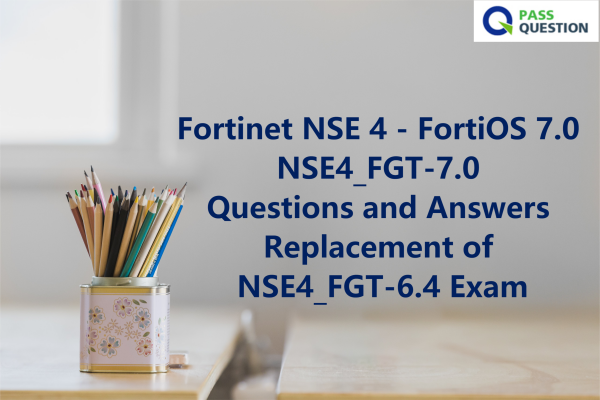Fortinet NSE 4 - FortiOS 7.0 NSE4_FGT-7.0 Questions and Answers Replacement of NSE4_FGT-6.4 Exam
NSE4_FGT-7.0 Fortinet NSE 4 - FortiOS 7.0 Exam is the new NSE 4 Certification exam replacement of Fortinet NSE 4 - FortiOS 6.4 NSE4_FGT-6.4 exam which will be retired on March 31, 2022. You can get the latest Fortinet NSE 4 - FortiOS 7.0 NSE4_FGT-7.0 Questions and Answers from PassQuestion to prepare well for your exam,all the exam questions are designed on the exact pattern so it allows you to experience as in an real exam. PassQuestion Fortinet NSE 4 - FortiOS 7.0 NSE4_FGT-7.0 Questions and Answers are according to the real exam pattern and help you to cover all the topics and objectives of NSE4_FGT-7.0 exam. If you study NSE4_FGT-7.0 exam once you will pass your exam with high grades in the first attempt.

NSE4_FGT-7.0 Exam Overview - Fortinet NSE 4 - FortiOS 7.0
The Fortinet NSE 4 - FortiOS 7.0 exam is part of the NSE 4 Network Security Professional program, and recognizes the successful candidate's knowledge of and expertise with FortiGate. The exam tests applied knowledge of FortiGate configuration, operation, and day-to-day administration, and includes operational scenarios, configuration extracts, and troubleshooting captures. The Fortinet NSE 4 - FortiOS 7.0 exam is intended for network and security professionals responsible for the
configuration and administration of firewall solutions in an enterprise network security infrastructure.
Exam Information
Exam name: Fortinet NSE 4 - FortiOS 7.0
Exam series: NSE4_FGT-7.0
Time allowed: 105 minutes
Exam questions: 60 multiple-choice questions
Scoring Pass or fail, a score report is available from your Pearson VUE account
Language: English and Japanese
Product version: FortiOS 7.0
Exam Objectives
FortiGate deployment
- Perform initial configuration
- Implement the Fortinet Security Fabric
- Configure log settings and diagnose problems using the logs
- Describe and configure VDOMs to split a FortiGate into multiple virtual devices
- Identify and configure different operation modes for an FGCP HA cluster
- Diagnose resource and connectivity problems
Firewall and authentication
- Identify and configure how firewall policy NAT and central NAT works
- Identify and configure different methods of firewall authentication
- Explain FSSO deployment and configuration
Content inspection
- Describe and inspect encrypted traffic using certificates
- Identify FortiGate inspection modes and configure web and DNS filtering
- Configure application control to monitor and control network applications
- Explain and configure antivirus scanning modes to neutralize malware threats
- Configure IPS, DoS, and WAF to protect the network from hacking and DDoS attacks
Routing and Layer 2 switching
- Configure and route packets using static and policy-based routes
- Configure SD-WAN to load balance traffic between multiple WAN links effectively
- Configure FortiGate interfaces or VDOMs to operate as Layer 2 devices
VPN
- Configure and implement different SSL-VPN modes to provide secure access to the private network
- Implement a meshed or partially redundant IPsec VPN
View Online Fortinet NSE 4 - FortiOS 7.0 NSE4_FGT-7.0 Free Questions
Which three CLI commands can you use to troubleshoot Layer 3 issues if the issue is in neither the physical layer nor the link layer? (Choose three.)
A.diagnose sys top
B.execute ping
C.execute traceroute
D.diagnose sniffer packet any
E.get system arp
Answer : B, C, D
Which two VDOMs are the default VDOMs created when FortiGate is set up in split VDOM mode? (Choose two.)
A.FG-traffic
B.Mgmt
C.FG-Mgmt
D.Root
Answer : A, D
A network administrator has enabled full SSL inspection and web filtering on FortiGate. When visiting any HTTPS websites, the browser reports certificate warning errors. When visiting HTTP websites, the browser does not report errors.
What is the reason for the certificate warning errors?
A.The browser requires a software update.
B.FortiGate does not support full SSL inspection when web filtering is enabled.
C.The CA certificate set on the SSL/SSH inspection profile has not been imported into the browser.
D.There are network connectivity issues.
Answer : C
An administrator has a requirement to keep an application session from timing out on port 80. What two changes can the administrator make to resolve the issue without affecting any existing services running through FortiGate? (Choose two.)
A.Create a new firewall policy with the new HTTP service and place it above the existing HTTP policy.
B.Create a new service object for HTTP service and set the session TTL to never
C.Set the TTL value to never under config system-ttl
D.Set the session TTL on the HTTP policy to maximum
Answer : B, C
In which two ways can RPF checking be disabled? (Choose two )
A.Enable anti-replay in firewall policy.
B.Disable the RPF check at the FortiGate interface level for the source check
C.Enable asymmetric routing.
D.Disable strict-arc-check under system settings.
Answer : C, D
- TOP 50 Exam Questions
-
Exam
All copyrights reserved 2025 PassQuestion NETWORK CO.,LIMITED. All Rights Reserved.

